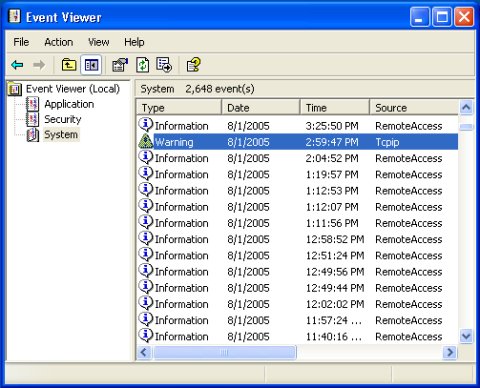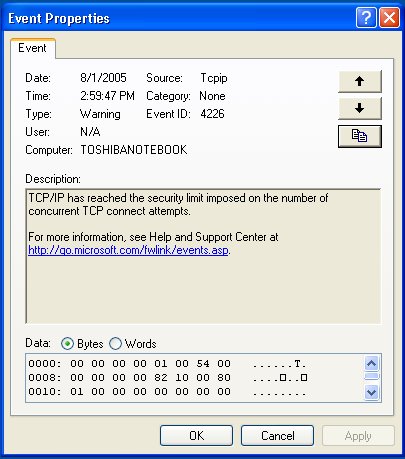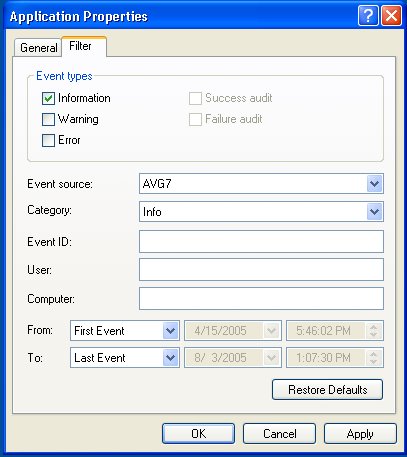- Some applications create their own separate event log which is displayed in Event Viewer along with Windows standard Application, Security and System event logs. Sometimes an aplication will leave its event log behind after you uninstall it. You can remove the log by removing its subkey from the key:
Also remove the associated file from the folder:
\Windows\system32\config
It will have an .evt extension. But never remove AppEvent.evt, SecEvent.evt, or SysEvent.evt, the Application, Security and System event logs.
To view an event log, in Control Panel select the Administrative Tools. In the Administrative Tools window, select the Event Viewer. You can also open Event Viewer by selecting Start | Run and typing eventvwr.msc in the Run dialog box.

An Error event records that a critical error has occurred. You might want to investigate an Error event before it becomes a more serious problem. To view the details of an event, double-click on the event in the list. The Event Properties dialog box will open. The Event Properties dialog box Description section will display a description of the event, and maybe a link to a source of more information about that type of event.

How to Use Event Description Information
The information provided by the Event Properties dialog box should point you towards the source of the problem. Use your regular troubleshooting tools, resources, and techniques to solve the problem.
If the Event Properties dialog box includes a link to Micosoft's website (and your computer is connected to the Internet), click on the link. This will execute the Microsoft Help and Support Center which will retrieve information related to the error from Microsoft's web site. This information may include instructions about how to solve the problem, along with links to relevant information on Microsoft's web site.
You can also visit the Microsoft Knowledge Base where you can search for information by typing the error description or a question into the search box. You can also type the error description into a general search engine to perform a general web search.
When to Use Event Viewer
Use the Event Viewer when an error occurs while using your computer. Windows will generate an Error event log proving details about the error. You'll want to review the event log immediately after the error.
Use the Event Viewer before and after you make a major change to the system. Inspect the event logs before installing software, hardware, or making a major configuration change. Then, after a short interval, view the event logs again to see if the change is causing warning or error events.
Review the event logs periodically to learn about problems that may not be apparent from the operation of the computer, but can become serious if not attended to.
Set Event Log Options
You can set several Event Log options to aid in troubleshooting and improve Windows performance. In the left pane of Event Viewer right-click on one of the event logs and select Properties in the popup menu. The log's Properties dialog box will appear.



In order to maintain the log size at 64 KB, when a new event occurs, the oldest event will be overwritten. An alternative configuration would be to leave the log size at 512 KB, but set the log to overwrite events older than a certain date. You can also configure it to allow you to clear events manually.
Security Log
Each time you logon or logoff the system, a Security event is created. In a corporate network environment, system administrators will regularly analyze the Security log for signs of hacker activity. There are third party applications that can perform this analysis for them.
Anything noteworthy that happens in Windows is recorded in an "event log". Most people ignore these logs; however, they can be very useful for troubleshooting purposes.

No comments:
Post a Comment